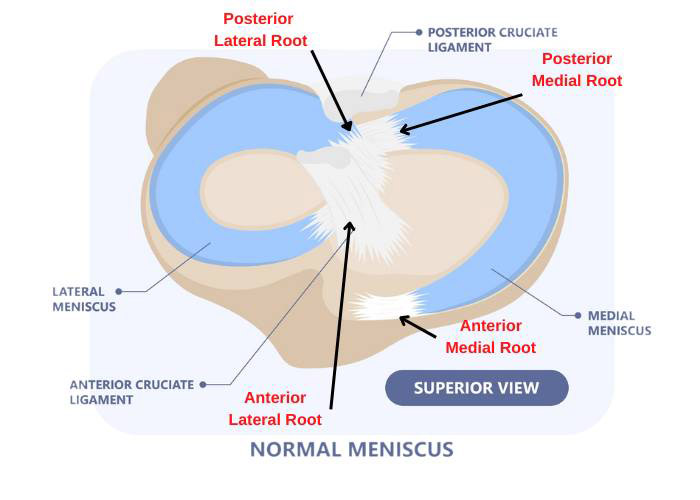Meniscus Root Tear Specialist
Did you twist your knee playing a sport or stepping off a curb? Do you have knee pain or stiffness? You may have a meniscus root tear in the knee joint. Left untreated, it can lead to knee osteoarthritis. Meniscus root tear specialist Dr. Prem N. Ramkumar provides non-surgical and surgical treatments for patients with a meniscus root tear. His office is located in Long Beach and serves Los Angeles, Orange County, and surrounding Southern California areas. Contact Dr. Ramkumar’s team for an appointment today!

What is a meniscus root tear?
The medial (inner) and lateral (outer) knee menisci are attached to the bone with what are called “roots”. These roots are responsible for holding the meniscus in place. Without the root attachments, the meniscus flops around the knee, and the joint no longer has an effective shock absorber. For decades it was not clear what role the meniscus roots played in the knee’s biomechanics, but now it is better understood although there will always be more to understand.
A meniscus root tear can result from either an acute and severe knee injury or represent a chronic and arthritic knee that is wearing and tearing through the meniscal shock absorbers from the underlying cartilage wear. When the root is detached, the meniscus is nonfunctional. If you suffer a meniscus root tear, your knee joint no longer has a cushion and will carry more than three times the usual load. If left untreated in the acute setting with intact cartilage (no signs of arthritis), the root tear can lead to early-onset arthritis. Dr. Prem N. Ramkumar, meniscus root tear specialist, is located in Long Beach and serves the Los Angeles, Orange County, and surrounding Southern California areas.

How does a meniscus root tear occur?
You can suffer a meniscus root tear, either from trauma or degeneration. Traumatic tears usually occur in younger athletes, caused by a sudden twist to the knee. Such tears are often located in the lateral meniscus and can be associated with an ACL tear. Degenerative tears occur in middle-aged and older patients, more commonly affecting the medial meniscus. These patients typically start having pain often in the back of the knee after stepping off a curb or a stair the wrong way.
What are the symptoms of a meniscus root tear?
A traumatic meniscus root tear is common for athletes and frequently occurs with other injuries, like an ACL tear. Symptoms can include:
- Pain
- Joint dysfunction (knee does not move properly)
- Swelling and stiffness
- Instability
A degenerative meniscus root tear usually affects middle-aged and older patients. Symptoms can include:
- Aching in the back of the knee
- Increase in pain with vigorous activities
- Inability to bear weight on the knee
- Stiffness, swelling, and instability
- Popping Noise
How is a meniscus root tear diagnosed?
Dr. Ramkumar will take an extensive medical history and perform a thorough physical examination of your knee. He will focus on previous knee injuries and ask what type of activity led to your knee pain. He may order X-Rays, an MRI, or both to rule out other injuries to the knee joint.
What are the treatment options for a meniscus root tear?
Non-Surgical:
Non-Surgical treatments are ideal for elderly patients with enough cartilage damage where arthroscopic surgery would not sufficiently eliminate pain and where arthroplasty may be premature or aggressive. Those treatments include:
- Activity modification
- Rest
- NSAIDs (non-steroidal anti-inflammatory drugs) to manage pain
- Physical therapy (to strengthen muscles and increase flexibility).
- Injections (hyaluronic acid, cortisone)
Surgical:
Dr. Ramkumar will recommend arthroscopic surgery for patients still suffering from pain after non-surgical treatments. If trauma is the cause of your meniscus root tear, surgery prevents further damage to the meniscus and reduces the onset of osteoarthritis.
The meniscus root repair is done arthroscopically and stabilizes the knee by re-anchoring the torn meniscus to the tibia (shinbone). Dr. Ramkumar tries to preserve as much meniscus tissue as possible. There are three ways to repair a meniscus root tear:
- Partial meniscectomy – This is the most common surgery to address a meniscus root tear. The injured part of the meniscus is removed to relieve pain. This is often performed when the root tear is incomplete and removing the tissue would not destabilize the entire meniscus.
- Repair with pull-out tunnel technique – One or two small tunnels are drilled through the tibia bone. Sutures are used to secure the root back to the bone. A small incision is made on the surface of the tibia (shin bone) to fix the sutures holding the meniscal root in its place.
- Repair with side-to-side sutures: This refers to the use of simple stitches to sew a split meniscus back together.
The total recovery time for a meniscus root repair to get back to full demand activities is usually 4-6 months. You won’t be allowed to put weight on the knee for 1-2 weeks following surgery. After that, you will wear a brace and undergo physical therapy to regain strength and increase range of motion.

